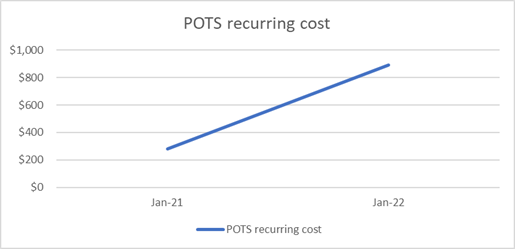Over the last several months, there has been a great deal of discussion and a lot of articles written about the demise of POTS (Plain Old Telephone Service) lines. Some organizations have been proactive in addressing the issue and others have not done anything and have taken an “if it ain’t broke – don’t fix it” attitude.
A recent FCC ruling has removed the requirements for carriers to provide analog, copper-based services at competitive rates. These services include voice-grade analog lines (including fire and burglary alarms, elevator lines, entry systems, and backup circuits), T1s, PRI circuits, and others. This does not mean that your services will one day stop working. But the recurring costs and new circuit availability can be changing dramatically.
From a vendor perspective, this is something that has been on their roadmap for several years. The copper-based infrastructure has been the lifeblood of their revenue, but it is aging, becoming more expensive to install and maintain, and people who are trained on the services are retiring. Newer fiber-based services are what they are building.
What does this mean for users? In general, it means that these services will become more of a headache for IT and telecom managers.
Costs will continue to rise. If you have copper lines that are not under contract, do a cost comparison of those lines from 6 – 12 months ago and you will see a significant rise in costs. We have seen costs increase by more than 200%. One client we are working with has seen costs increase from $274 to $890 per month. Take a look at the graph below of the trend in recurring costs.

And, at the end of the contract term, you cannot assume that you can renew the contract at the current rate.
The time to repair will get longer. Carriers are deprioritizing the maintenance of these services. Materials needed to maintain the infrastructure are not being stored and the labor force required is aging out and they are not being replaced. Intermittent service issues will be difficult to get addressed and resolved.
New copper services won’t be available. Although current copper-based services won’t be turned off, it is probable that new services will not be available. Carriers will stop taking orders and instead propose fiber-based services.
Regardless of the organization’s size or the number of lines involved, you will be impacted by these changes. And there isn’t a better time to get prepared. Use the following links for insight!
The first step is to become AWARE. Do a complete audit and inventory of all lines, circuits, contracts, and costs to determine what services are at risk for increased costs. Take note of any anomalies like unexpected cost increases and look for services that are not being used.
Then ANALYZE what options are available. Most carriers have products and services that can provide the functionality of legacy services. But it is not an overnight process, and the transition needs to be monitored. Do an analysis of before and after costs to ensure the economic benefit is there. Make sure that the services you are replacing are actually needed.
Finally, take ACTION or be prepared to take action at the right time.
If your company doesn’t have the time or the resources to perform these tasks, or if you would like to talk to an independent consultant, please contact us by calling our number above or by email at info@abilita.com. Your query will be directed to one of our regional offices for a quick reply.
